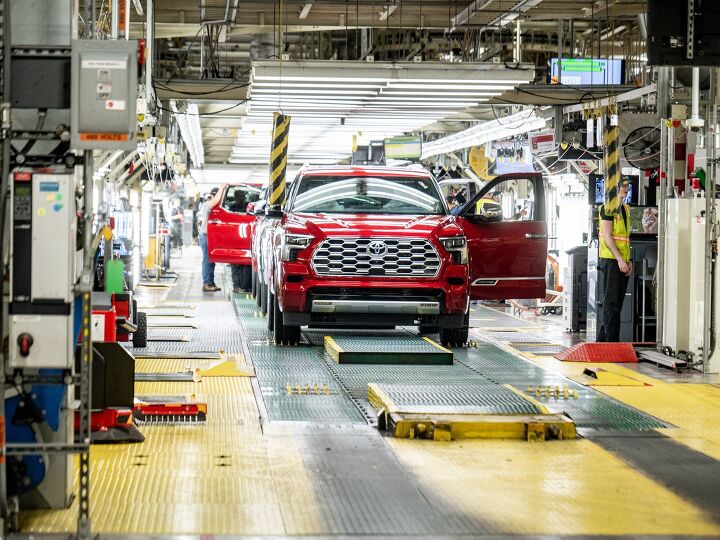Toyota Assembly Plant in Texas Turns Twenty

Whilst we don’t generally run news of this sort, it is worth noting that this month represents a full two decades since Toyota put shovels in the ground to build what would become their San Antonio truck plant, a spot which currently cranks out Tundra and Sequoia machines.
Why is it worth noting? Because the products that pop from this plant are one of the few that have had even a meager amount of success in challenging the Detroit Three in the half-ton truck game. Other challengers have come and gone but the Tundra and Sequoia have managed to stick around and be relatively successful. That’s something to crow about – even if the market share of these models remains a sliver of what Detroit grabs every year.
Since breaking ground in 2003, Toyota Texas has assembled upwards of 3 million trucks and SUVs since production started in 2006. The company claims this place represents $4.2 billion in the Lone Star State, though specifics on that figure are tough to nail down. Suffice it to say that any automotive plant producing this many vehicles has far-reaching positive effects on the area in which it is located, from direct jobs to supplier contracts to local businesses that benefit from people spending their Toyota paychecks.
If you need a brief history lesson, the Tundra has been produced steadily at this facility since it opened in 2006, though the Sequoia only began life there in 2022. That was one year after Tacoma production was shuttled off elsewhere, ending an 11-year run that began in 2010. Through the third quarter of this annum, just over 92,000 Tundra pickups have been sold plus about 15,000 Sequoia SUVs.
Toyota has also donated more than $50 million to local nonprofit organizations, including a hundred grand this week to The Institute for School & Community Partnerships at Texas A&M University San Antonio and The 100 Club of San Antonio. It seems the names of societies in Texas are as big as the state itself.
[Images: Toyota]
Become a TTAC insider. Get the latest news, features, TTAC takes, and everything else that gets to the truth about cars first by subscribing to our newsletter.

Matthew buys, sells, fixes, & races cars. As a human index of auto & auction knowledge, he is fond of making money and offering loud opinions.
More by Matthew Guy
Latest Car Reviews
Read moreLatest Product Reviews
Read moreRecent Comments
- Varezhka Dunno, I have a feeling the automakers will just have the cars do that without asking and collect that money for themselves. Just include a small print in your purchasing contract.I mean, if Elon Musk thinks he can just use all the Teslas out there for his grid computing projects for free, I wouldn't be too surprised if he's already doing this.
- Varezhka Any plans yet for Stellantis to wind down some of their dozen plus brands? I mean, most of their European brands (except Fiat and Maserati) are not only 80~90% European sales but also becoming old GM level badge jobs of each other. Lots of almost identical cars fighting within the same small continent. Shouldn't they at least go the Opel/Vauxhall route of one country, one brand to avoid cannibalization? The American brands, at least, have already consolidated with Dodge/Chrysler/Jeep/RAM essentially operating like a single brand. An Auto Union of a sort.
- Namesakeone I read somewhere that Mazda, before the Volkswagen diesel scandal and despite presumably tearing apart and examining several Golfs and Jettas, couldn't figure out how VW did it and decided then not to offer a diesel. Later, when Dieselgate surfaced, it was hinted that Mazda did discover what Volkswagen was doing and kept quiet about it. Maybe Mazda realizes that they don't have the resources of Toyota and cannot do it as well, so they will concentrate on what they do well. Maybe Mazda will decide that they can do well with the RWD midsized sedan with the inline six they were considering a few years ago
- IH_Fever A little math: An average, not super high end EV (like a model 3) has 70 kwh of storage assuming perfect fully charged conditions. An average 2-3 person home uses roughly 30 kwh per day. So in theory you have a little over 2 days of juice. Real world, less than that. This could be great if your normal outage is short and you're already spending $50k on a car. I'll stick with my $500 generator and $200 in gas that just got me through a week of no power. A/c, fridge, tv, lights, we were living large. :)
- EBFlex No. The major apprehension to buying EVs is already well known. The entire premise of the bird cage liner NYT is ridiculous.The better solution to power your house when the power goes out is a generator. Far more reliable as it uses the endless supply of cheap and clean-burning natural gas.



































Comments
Join the conversation
Is that 3 million vehicle number correct? It averages out to 150,000 vehicles a year, that seems like a rather lower volume plant.
Too bad for all of those rusty truck frames getting through.